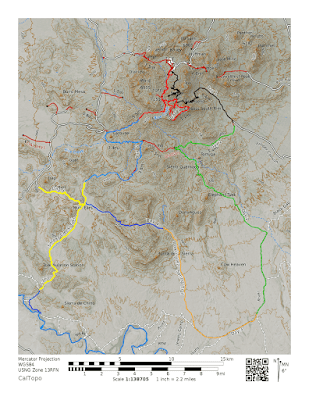Get Your Dog Ready to Run
Start Preparing Your Dog to Run
Now that it has finally
cooled off, it’s time for BeeGee to start joining me on mountain bike
rides. I am really pumped about this and
I bet she will be too. Unfortunately,
with the move from North Carolina and the heat of south Texas, I have neglected
our weekly runs. So, I have put together
a small guide to help you guys get ready to run with your pups (and help
me!). This article was updated December 16, 2014.
The Preparation
First things first,
ensure your dog is healthy enough to even begin training with you, which should
be done by your veterinarian. Moreover,
pets that are too old or too young shouldn’t run either. Young dog’s bones are still developing and
training should wait until they are over 6 months. Furthermore, large and giant breeds need to
wait even longer, around 18 months. As for older dogs, that is harder to set a specific time frame, so just be safe and consult your vet.
The Run
One of the most
important parts of running with you dog is good leash skills. This might be the hardest part, but training
your pup to run next to you and not pull can be a huge challenge. Also, you must teach your dog not to step
every few feet not to mark to prevent frequent breaks. A gentle tug on the leash and saying, “let’s
go” works well with BeeGee.
Just like people,
dogs need to slowly build up as they get in shape. For beginners with no cardio training, I recommend
just regular walks to start with. This
gets the pup ready by strengthening/toughing their pads, increasing their
cardio a little, and familiarization with leash rules. The next step will be adding short 5-minute
jogs into your regular walks 2 – 3 times a week. After a few weeks, increase the jogging time
to 10 minutes. This should provide a
nice base for your dogs and maybe you.
Finally, start running 3 times a week.
BeeGee and I have started with 2-mile runs 2 to 3 times a week, but time
based runs might work better. I would
start at 15 to 20 minutes per run.
Finally, add about 5 minutes per run every week.
Keeping Control
During a run using a leash, it is extremely
important to keep control over your dog. By not keeping control of your dog,
you risk injury to yourself, your dog, and innocent bystanders (other runners
or squirrels). First, keep your dog on leash. It will keep your dog
out of danger and it will make everyone else feel a little safer, even if your
dog is perfectly trained. It's just a matter of courtesy. Second,
you must remember it’s a run not a walk or fun time. Next, no stopping to
sniff or mark. These kinds of sudden stops because of your dog can result
in injury to you or your buddy. Like you falling over your dog or a quick
painful jerk to your dog's neck.
Keeping control of your dog can be made easier
with the right equipment. This can be accomplished by using a good leash
and a collar or harness. I don't recommend training (choke chains or
pinch collars) collars because this can decrease the efficiency of your dog's
breathing. If the collar is tight throughout the run it will make it a
lot harder if your dog isn't getting the oxygen she needs. Furthermore,
if your dog is a known puller, try using a good harness. This will take
the pressure and jerks away from their necks, which will allow them to breathe
easier and reduce injury causing neck jarring. Finally, consider a leash
with a little give. This will also take out some of the sudden, hard
jerks.
Signs to Slow Down or Quit
Sometimes we bite
off more than we can chew, don’t fully recover, or have a bad day, and our running
buddies are no different. If you start
seeing any of the signs below, take a quick stop, wait for your dog to recover,
and then continue again at a slower pace.
If the signs persist, it’s time to call it quits and walk on home.
Here are a few signs
to look for:
- Running behind you instead of at your side or slightly ahead
- Ears back
- Tongue hanging out and to the side
- Corners of the mouth pulled back
- Lays down or quits running
- Mega pants and difficulty breathing
After the Run
After you finish up
your awesome run and cool down, it’s pretty important to check out your dog’s
paws. Unfortunately, our dogs can’t talk
and let us know their issues, so we have to give them a once over. Start by checking for cuts, scratches, and
worn down pads on their paws. Then
examine their coats for burrs, ticks, or any other material that could be matted
in. Finally, watch your dog’s gait (aka
their walk) to see if they are limping.
After you've given them an inspection, its time to let them cool off before you let them drink water or provide a snack. However, once they have cooled down, make sure you provide plenty of water and a post work out snack.
After you've given them an inspection, its time to let them cool off before you let them drink water or provide a snack. However, once they have cooled down, make sure you provide plenty of water and a post work out snack.
Lessons Learned and Tips
- Make sure to take a few bags for bathroom clean ups
- Know where a trash can is on the route (I've spent more than a few miles running with a full bag because of this)
- Take water for you and your dog if you plan on running in the heat or over 3 miles
- No food for 1 hour before and 1 hour after to prevent bloating
Final Thoughts
It is great that you
want to get out there and run or bike with your pup. I hope this short guide has helped you decide
to start training with your dog because it’s so much more fun running with someone
else. Especially with man’s best friend!
.jpg)
.jpg)



Comments
Post a Comment